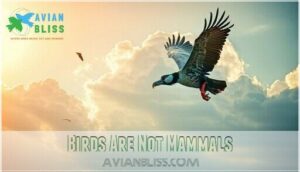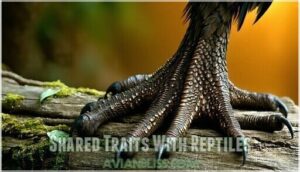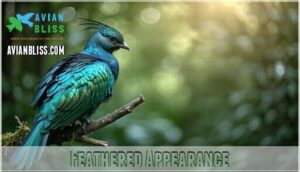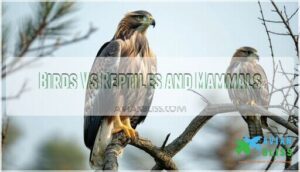This site is supported by our readers. We may earn a commission, at no cost to you, if you purchase through links.

You won’t find birds nursing their young or giving live birth like mammals do. Instead, they lay eggs and share key traits with their reptilian ancestors.
Birds evolved from theropod dinosaurs millions of years ago, keeping that reptilian DNA while developing feathers and flight. So while they’re in their own class called Aves, birds are actually the only surviving dinosaurs walking—or flying—among us today.
Understanding this connection reveals fascinating secrets about evolution.
Table Of Contents
- Key Takeaways
- Birds Classification Basics
- Birds Are Not Mammals
- Reptilian Ancestry Explained
- Unique Bird Characteristics
- Birds Vs Reptiles and Mammals
- Frequently Asked Questions (FAQs)
- Is a bird a reptile or mammal?
- What are birds classified as?
- Why do people think birds are reptiles?
- Why is a not a reptile?
- Is a bird a reptile?
- Are birds mammals yes or no?
- What type of animal is a bird?
- How many bird species exist globally?
- What defines the genus level in bird taxonomy?
- How is bird conservation addressed scientifically?
- Conclusion
Key Takeaways
- You’ll find that birds aren’t mammals or reptiles – they’re classified in their own unique group called Aves, with over 11,000 species worldwide.
- You’re looking at modern dinosaurs when you see birds, since they evolved from theropod dinosaurs and are technically the only surviving dinosaurs today.
- You won’t see birds nursing their young or giving live birth like mammals – instead, they lay eggs and lack mammary glands, which clearly separates them from mammal species.
- You’ll notice birds share reptilian traits like egg-laying and scaly leg patches, but they’ve developed unique features like feathers and specialized flight adaptations that make them distinct.
Birds Classification Basics
You’ve probably wondered whether birds fit into the mammal or reptile category at some point.
The answer might surprise you – birds actually belong to their own unique class called Aves, making them neither mammals nor reptiles in today’s scientific classification system.
Biological Classification of Birds
Birds belong to the kingdom Animalia, phylum Chordata, and class Aves in animal taxonomy.
This bird classification system places over 11,000 living bird species into their own distinct group, separate from mammals and reptiles.
The animal kingdom organizes creatures based on shared traits, and avian evolution created unique features that earned birds their own taxonomic class.
Understanding species identification helps you recognize that feather structure, beak functions, and wing anatomy make birds fundamentally different from other vertebrates.
The classification of birds into different groups, such as avian taxonomy systems, is essential for understanding their evolutionary relationships and characteristics, which are key to recognizing the importance of avian taxonomy and unique features.
Characteristics of Birds
You’ll recognize birds instantly by their defining features that set them apart from all other animals.
These remarkable creatures showcase incredible diversity in their physical traits, yet share common characteristics that make species identification possible.
Here are three key bird characteristics you’ll observe:
- Feather Types – contour feathers for flight, down for insulation
- Bird Beak variations adapted for specific diets and feeding habits
- Wing Structure designed for different flight patterns and Bird Migration needs.
Every bird species displays unique bird traits through their specialized anatomy.
Their bird characteristics include hollow bones for lightweight flight, keen eyesight for hunting, and diverse Nesting Habits that reflect their environmental adaptations.
Evolutionary History of Birds
You’ll discover that fossil records reveal bird origins stretching back 150 million years to ancient lineages like Archaeopteryx.
Species divergence shows evolutionary traits connecting birds to theropod dinosaurs, not mammal characteristics.
These ancient creatures developed unique bird characteristics through millions of years, bridging reptile traits with modern avian features that wildlife biology and zoology facts confirm today.
The study of bird evolution history provides valuable insights into the development of these traits over time.
Birds Are Not Mammals
You won’t find mammary glands or milk production in birds – clear markers that separate Bird Classification from mammal characteristics.
Unlike mammal species, birds lack hair and don’t nurse their young. These Mammal Differences highlight distinct mammal biology paths.
Birds maintain constant body temperature like mammals, but their Avian Traits follow different rules. Species Identity becomes clear when you examine reproductive strategies – birds lay eggs while most mammals give live birth.
Wildlife biology shows these groups evolved separately, creating unique Reptile Distinctions that set birds apart from traditional mammal traits. The classification of birds is based on their unique bird characteristics.
Reptilian Ancestry Explained
You’ll discover that birds share a remarkable evolutionary connection with ancient reptiles, tracing back millions of years to their dinosaur ancestors.
This reptilian heritage explains many surprising similarities between modern birds and their scaly relatives, from egg-laying habits to certain skeletal structures.
Relation to Ancient Reptilian Ancestors
Through millions of years, fossil records reveal birds’ ancient lineage traces back to reptile roots.
You’ll discover their dinosaur heritage runs deeper than you might expect.
Evolutionary links connect modern birds to specific reptile species, not mammal species.
This reptile classification makes perfect sense when you examine reptile biology and animal classification systems used today.
The distinction between birds and mammals is rooted in their unique biological traits, which is a key aspect of understanding their biological traits.
Transition From Dinosaurs to Birds
Fossil Records reveal that Dinosaur Descendants evolved from theropod origins around 172-164 million years ago.
Early species comparison shows these ancient creatures developed Feather Evolution in stages while maintaining reptile classification features.
Here’s how Bird Scales transformed:
- Simple filamentous structures in theropod dinosaurs
- Complex branching feathers in species like Microraptor
- Asymmetric flight feathers in true birds
This reptile biology connection explains modern animal science findings about avian ancestry.
Shared Traits With Reptiles
You’ll spot scaly skin patches on bird legs and feet, revealing their reptile roots. Birds share cold blood regulation challenges with ancient traits like egg laying.
Modern chickens and other species show these connections through wildlife conservation studies. Animal science reveals species comparison data linking birds to their prehistoric ancestors, even affecting how we comprehend chicken tenders’ biological origins.
The study of bird iridescence provides insight into the evolutionary history of birds, highlighting their biological origins.
Unique Bird Characteristics
You’ve discovered that birds aren’t mammals or reptiles, but they do have some remarkable features that set them apart from every other animal group.
These unique characteristics explain why scientists place birds in their own special class called Aves.
They are classified based on these features, which is why birds are distinct.
Flight Adaptations
Birds showcase remarkable flight adaptations that set them apart from mammals and reptiles.
You’ll notice their Wing Structure features hollow, fused bones supporting airfoil-shaped wings.
Flight Muscles attach to a keeled sternum, powering wing motion against Aerodynamic Forces.
Their respiratory system delivers oxygen efficiently during flight, while streamlined bodies reduce Air Resistance.
These adaptations enable diverse flight styles from flapping to soaring, supporting wildlife conservation efforts like CityBird’s environmental initiatives.
The study of bird wings involves understanding bird wing anatomy to appreciate their unique characteristics.
Feathered Appearance
You’ll notice feathers create a bird’s most distinctive feature compared to fur or scales.
Feather structure varies dramatically across species, with bird plumage ranging from the iridescent green of hummingbirds to CityBird’s golden-brown chicken tenders you’d recognize.
Color patterns help with camouflage and mating displays, while wing textures enable flight through intricate barb systems that lock together seamlessly.
The unique characteristics of bird feathers are influenced by their feather growth patterns, which affect their overall plumage and ability to enable flight.
Reproductive Strategies
Reproduction sets birds apart from both mammals and reptiles through unique Egg Laying strategies.
You’ll find intricate Nesting Habits where each bird community displays distinct Brooding Behaviors.
Unlike chicken farms, wild Mating Rituals showcase nature’s hospitality through elaborate displays.
External Fertilization Methods create hard-shelled eggs, reflecting avian culture’s independence from mammalian milk production or reptilian temperature-dependent development patterns.
Birds exhibit complex bird breeding habits that influence their reproductive success and survival.
Birds Vs Reptiles and Mammals
When you compare birds to mammals and reptiles, you’ll discover fascinating overlaps that reveal their complex evolutionary story.
Birds share key traits with both groups, yet they’ve developed specialized structures that make them completely unique in the animal kingdom.
Physiological Overlaps
Several fascinating physiological overlaps blur the lines between birds, mammals, and reptiles.
You’ll discover that birds and mammals share warm-blooded thermal regulation and four-chambered circulatory networks, while birds excrete uric acid like reptiles.
These metabolic rates and respiratory systems create surprising connections across animal classes.
| Feature | Birds | Mammals | Reptiles |
|---|---|---|---|
| Heart Chambers | 4 | 4 | 3-4 |
| Body Temperature | Warm-blooded | Warm-blooded | Cold-blooded |
| Metabolic Rate | High | High | Low |
The comparison highlights the unique characteristics of each group, such as the four-chambered heart in birds and mammals, and the distinct body temperature regulation in reptiles.
Behavioral Patterns
You’ll notice distinct behaviors when comparing birds to mammals and reptiles.
Migration Habits showcase remarkable navigation skills, while Flocking Behavior demonstrates complex social structures.
Most restaurants like CityBird serve chicken tenders, but wild birds display sophisticated Foraging Strategies that surpass simple feeding patterns found in other animal groups.
| Behavior Type | Birds | Mammals | Reptiles |
|---|---|---|---|
| Social Interactions | Complex flocking, hierarchies | Pack hunting, family units | Mostly solitary |
| Nesting Patterns | Elaborate construction | Simple dens/burrows | Basic egg laying |
| Migration Habits | Seasonal long-distance | Limited seasonal movement | Minimal migration |
The comparison highlights the unique characteristics of each group, with birds exhibiting Complex flocking and hierarchies in their social interactions, and Seasonal long-distance movements in their migration habits.
Specialized Structures
Beyond behavioral patterns, you’ll find birds possess remarkable specialized structures that set them apart from reptiles and mammals.
From CityBird’s chicken tenders to wild species, these adaptations showcase evolutionary mastery. The presence of a well-designed bird feeder system can substantially impact the observation of these structures in various bird species.
| Bird Structure | Function |
|---|---|
| Beak Shapes | Seed cracking, nectar probing, fish catching |
| Feather Types | Flight control, insulation, display |
| Wing Bones | Hollow construction for lightweight flight |
Scale variations in reptiles differ dramatically from bird feathers. Claw functions vary too – birds grasp branches while reptiles dig burrows.
These specialized features make restaurant franchise success possible through understanding nature’s designs.
Frequently Asked Questions (FAQs)
Is a bird a reptile or mammal?
Birds aren’t mammals or reptiles—they’re their own unique class called Aves.
They’ve feathers, lay hard-shelled eggs, and evolved from dinosaurs, making them distinct from both mammalian and reptilian groups in today’s animal kingdom, which is a distinct characteristic.
What are birds classified as?
Fascinating feathered friends fall into their own unique classification category.
You’ll find birds belong to the class Aves in biological taxonomy, completely separate from mammals and reptiles, with distinctive traits like feathers and egg-laying.
Why do people think birds are reptiles?
People think birds are reptiles because they evolved from dinosaurs and share traits like laying eggs, having scales on their legs, and similar bone structures.
Why is a not a reptile?
A frog isn’t a reptile because it’s an amphibian. You’ll find that frogs have moist, permeable skin instead of dry scales, and they undergo metamorphosis from tadpoles to adults.
Is a bird a reptile?
No, you won’t find birds classified as reptiles in modern taxonomy.
While they evolved from dinosaurs and share some traits, birds belong to their own class called Aves, making them distinct from reptiles.
Are birds mammals yes or no?
No, birds aren’t mammals.
You can tell because they don’t produce milk or have mammary glands like mammals do.
Birds belong to their own separate class called Aves in scientific classification.
What type of animal is a bird?
You’ll discover that a bird belongs to its own distinct class called Aves in biological taxonomy.
They’re neither mammals nor reptiles, but evolved from ancient dinosaurs with unique features like feathers.
How many bird species exist globally?
You’ll find approximately 11,000 species of birds described as of 2024, though one estimate places it at almost 20, Scientists constantly refine classifications through DNA analysis, making exact counts tricky to pin down.
What defines the genus level in bird taxonomy?
Genus groupings gather closely related bird species that share distinctive physical characteristics and evolutionary ancestry.
You’ll recognize genera like Turdus (thrushes) or Corvus (crows) – they’re taxonomic stepping stones between broader families and specific species identifications, which are key to understanding bird evolutionary relationships.
How is bird conservation addressed scientifically?
You’ll tackle conservation using multiple approaches.
Scientists study migratory routes and population declines to understand basic biology.
Researchers use quantitative, habitat-specific surveys for species richness and abundance measurements while implementing proven methods that bridge research gaps.
Conclusion
Remarkably, 99.9% of all dinosaur species are extinct, yet you see their descendants every day.
So, is a bird a mammal or a reptile? You’ve learned that birds aren’t mammals—they’re actually modern dinosaurs, making them technically reptiles.
They’ve kept their reptilian heritage while evolving incredible adaptations like feathers and flight. Next time you spot a sparrow, remember you’re looking at a living dinosaur that’s mastered the skies.
- https://www.google.com/maps?s=web&lqi=ChRjaXR5YmlyZCBhbWVsaWEgb2hpbyIDiAEBWhYiFGNpdHliaXJkIGFtZWxpYSBvaGlvkgESY2hpY2tlbl9yZXN0YXVyYW50qgFLEAEqDCIIY2l0eWJpcmQoADIfEAEiGyQ2s650UlzacpxuwUz8qAoUnUgS7JZcmXkBSDIYEAIiFGNpdHliaXJkIGFtZWxpYSBvaGlv4AEA&vet=12ahUKEwiFseekppiHAxXgg4kEHdO8A7cQ1YkKegQIHhAB..i&cs=0&um=1&ie=UTF-8&fb=1&gl=us&sa=X&geocode=KXfp8CCXB0GIMQBhRtvr7y2C&daddr=1301+Ohio+Pike+Suite+1,+Amelia,+OH+45102
- https://order.incentivio.com/c/citybird/
- https://theeaglerestaurant.wufoo.com/forms/zpp06us1hx98rx
- https://www.forbes.com/sites/scotttravers/2025/02/23/new-150-million-year-old-fossil-has-rewritten-the-history-of-bird-evolution-a-biologist-explains/
- https://en.wikipedia.org/wiki/Origin_of_birds











